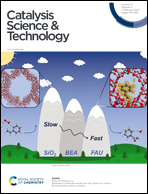Engineering heterometallic bonding in bimetallic electrocatalysts: towards optimized hydrogen oxidation and evolution reactions†
Abstract
Tuning the type and degree of heterometallic bonding in bimetallic catalysts is crucial to achieving optimal catalytic performance. In this study density functional theory (DFT) and X-ray absorption spectroscopy (XAS) were used to investigate the use of Ru-based bimetallic electrocatalysts for hydrogen oxidation/evolution reactions (HOR/HER) under alkaline conditions. The catalyst's hydrogen absorption and OH adsorption energies can both be tuned by altering the heterometallic bonding in bimetallic systems. DFT calculations were used in conjunction with a RuNi bimetallic system to optimize the hydrogen adsorption energy and weaken the OH adsorption energy. The degree of heterometallic bonding (i.e. the alloying extent) in the Ru2.3Ni1/C catalyst was experimentally confirmed by XAS analysis. Our findings indicate that tuning the hydrogen and OH adsorption energies on the RuNi bimetallic catalyst's surface leads to superior activity and stability in the alkaline HOR/HER compared to as-prepared Ru/C, commercial Pt/C and the reported catalysts. We showed that the oxophilic effect can be manipulated by altering heterometallic bonding and that both the hydrogen and OH adsorption energies are important determinants of the efficiency of low-cost HER/HOR catalysts in alkaline media.



 Please wait while we load your content...
Please wait while we load your content...